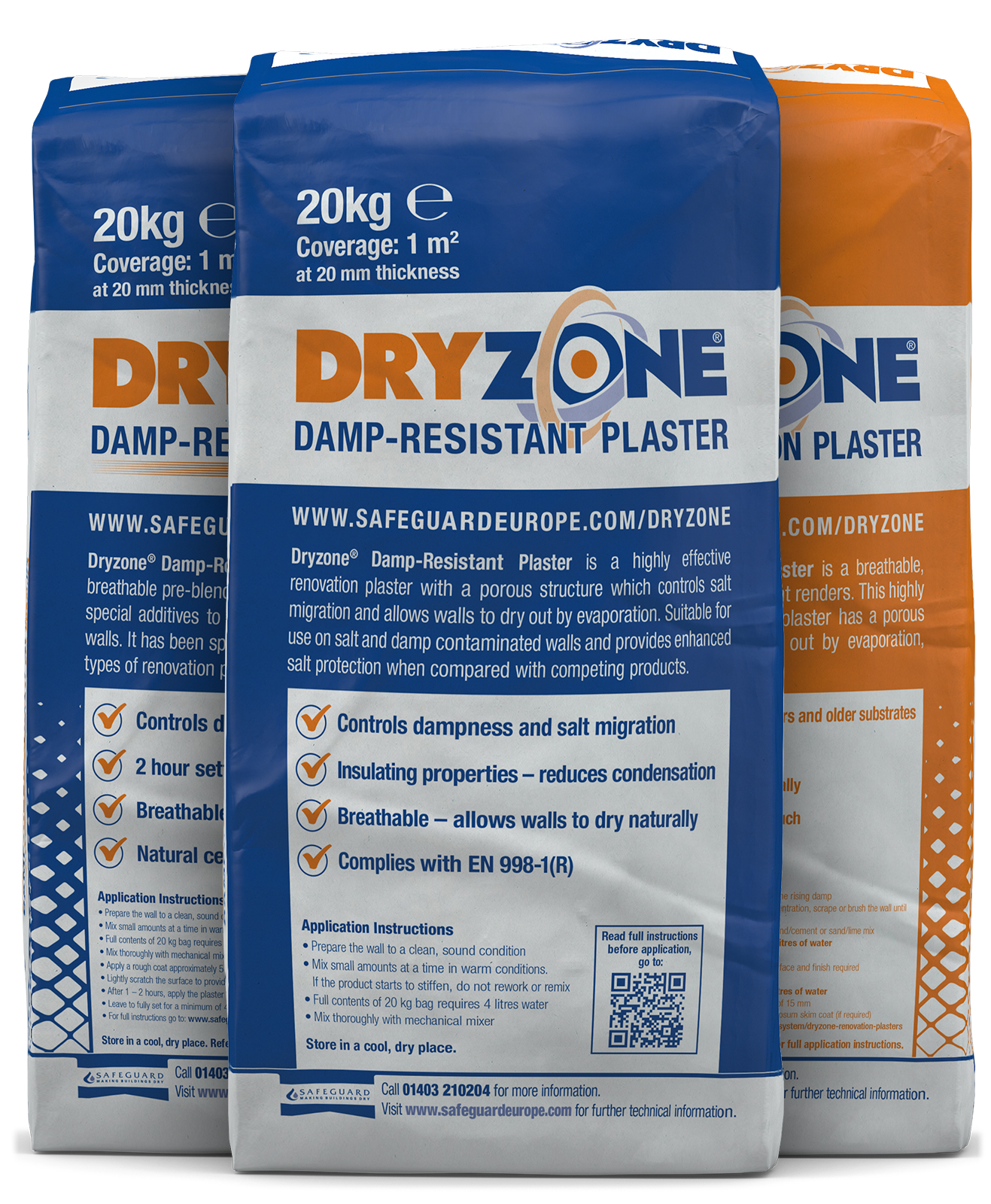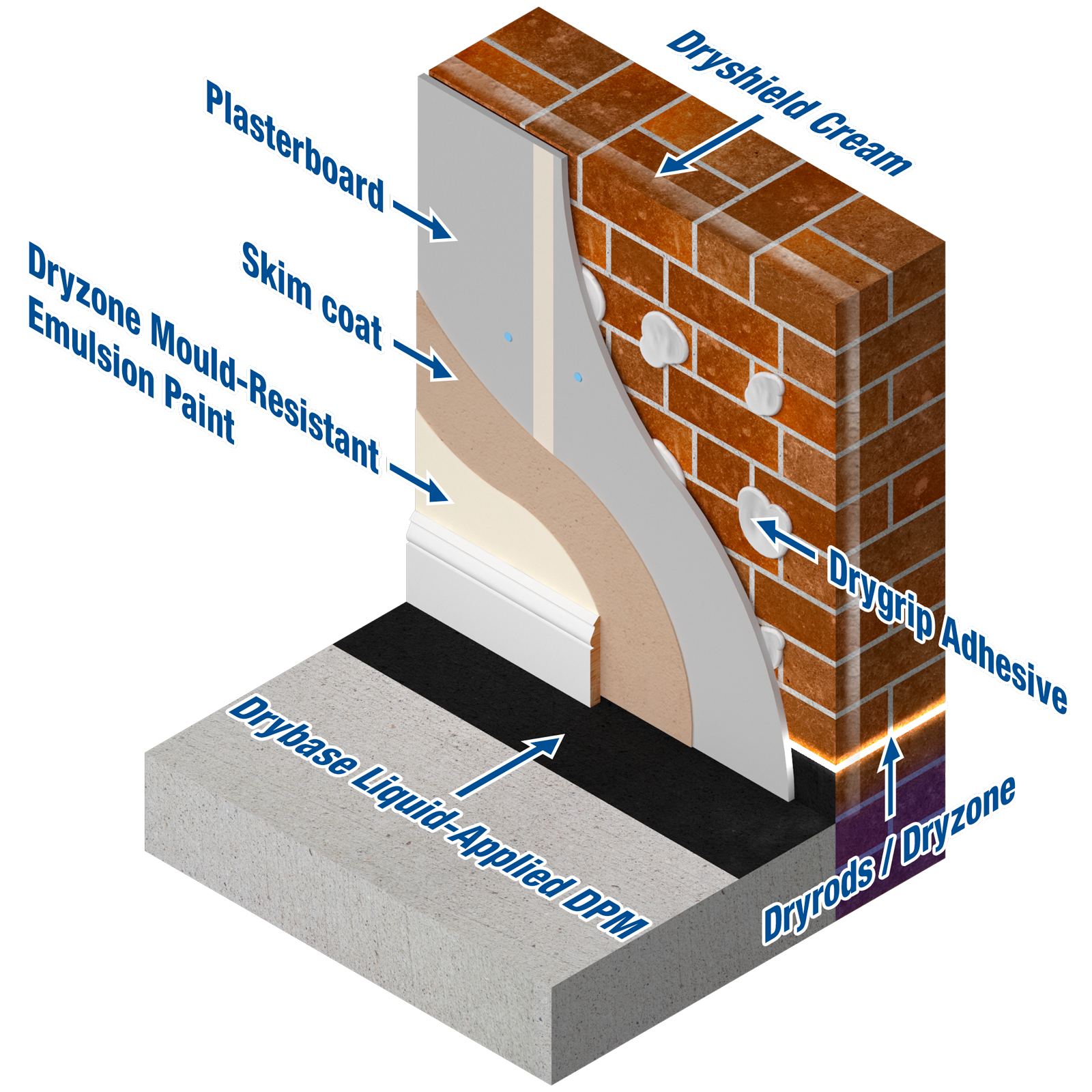Dryzone System Damp-Proofing Range
Rising damp occurs when groundwater rises up through walls, floors and masonry. Bricks and mortar can be very porous and contain many fine capillaries, through which water can rise. This can result in visible damp patches, salt-contamination and crumbling plaster on interior walls.
Most modern properties are built with a damp-proof course, commonly referred to as a DPC. Some properties, however, were built with no DPC, or the original has failed, meaning that rising damp can occur and it is necessary to make remedial repairs.
The Dryzone System range of products is designed to enable you to eliminate rising damp in these situations and renovate the interior walls that have been effected by it. Each product in the Dryzone System range is part of a system designed to enable the user to solve the problem of rising damp from start to finish.
How Does the Dryzone System Work?
Stop the Damp – With Our Patented Remedial Damp-proof Courses
In order to stop the progress of rising damp through a wall, it is necessary to create a new DPC. The most practical and effective way to do this is to make an existing mortar course into a waterproof barrier, using high strength damp-proofing products. There are two product choices for this purpose within the Dryzone System:
Dryzone Damp-Proofing Cream: This is a patented high-strength silicone-based cream that is injected into holes drilled at regular intervals along a mortar course. Once injected, the cream diffuses along the mortar course before curing to form a breathable water-repellent resin – preventing dampness from rising up the wall.
Dryzone was the very first DPC cream and revolutionised the market when it was launched in the year 2000. It still remains the most effective and most accredited DPC cream on the market today and is suitable for use in almost all rising damp situations.
Dryrod Damp-Proofing Rods: These patented 12 mm diameter fibre rods carry a powerful water-repellent material. They are simply inserted into holes drilled at regular intervals along a mortar course. Once inserted, the rods diffuse their water-repellent material along the mortar course, curing to form an effective barrier to rising damp.
The rods are an even more effective alternative to the industry leading Dryzone Damp-Proofing Cream and are suitable for situations that require maximum performance, guaranteed dosing or increased treatment speed.
Replaster – Using One of Our New Replastering Systems
Once a wall has been treated, it will begin to dry out but if the wall has been contaminated by groundwater salts then complications can arise, often leading to the appearance of damp patches, on an otherwise dry wall. Other issues that can arise include efflorescence forming at the plaster surface, causing decorative spoilage, and salts crystallising just underneath the plaster surface, causing it to crumble and blister.
This means that it is often necessary to replaster the affected wall after the treatment of rising damp. Standard plastering materials, such as gypsum plaster, are not suitable for replastering a salt-contaminated wall. Any salts that are still present in the building materials of the wall can migrate into the new plaster coat and symptoms of damp may reappear.
There are two recommended specifcations in the Dryzone System for replastering salt-contaminated walls:
Dryzone Renovation Plasters: This specification uses a modern formulation of breathable damp and salt-resistant plaster that is able to be applied with traditional plastering techniques. Unlike the sand and cement renders that are often used, Dryzone Renovation Plasters are non-destructive to the underlying masonry, do not require gauging and present a warm surface.
For older buildings, Dryzone Hi-Lime Renovation Plaster is also available. The plaster blend which contains a high proportion of natural hydraulic lime and calcite is highly breathable, quick drying and suitable for heritage applications.
Dryzone Express Replastering: This specification utilises plasterboard, which is adhered to the wall using a special damp and salt-resistant adhesive in conjunction with a paintable salt-inhibiting primer cream. This system provides the speed and convenience advantages of a traditional “dot & dab” plasterboard application and also provides a salt and damp-proof interior wall surface.
It is possible, with the use of dry-jointing techniques, to complete the replastering process from start to finish within 24 hours, making this specification ideal for situations where occupants/tenants need to re-enter the room as soon as possible.
Finish the Job – Using Dryzone Anti-Condensation Products
Once the replastering has been completed and the walls have been given the correct amount of time to dry out, it is then possible to reinstate the skirtings and redecorate the wall. It is important that any paint finishes applied are breathable in order to allow any dampness that is already in the wall to dry out.
For extra peace of mind, it is recommended to decorate and maintain your newly-refurbished wall with Dryzone anti-condensation products. Dryzone Mould-Resistant Emulsion Paint and Dryzone Anti Condensation Paint help prevent mould and condensation issues in cold or humid conditions. The Dryzone Mould Removal and Prevention Kit kills and eases the cleaning of black mould.
Find the Damp – Follow Our Comprehensive Guide
Rising damp can often be misdiagnosed. Low-level penetrating damp or bridged DPCs can produce very similar symptoms. It is important that you seek out the help of a professional surveyor in order to correctly identify the causes of any damp issue before attempting to remedy the problem. Incorrect treatment of dampness in a building can be costly, time-consuming and damaging.
For those who wish to know more, read Rising Damp & its Control, our in-depth guide to the identification and treatment of rising damp. The book gives the reader a step-by-step insight into the causes, symptoms and methods of treatment available to them.














